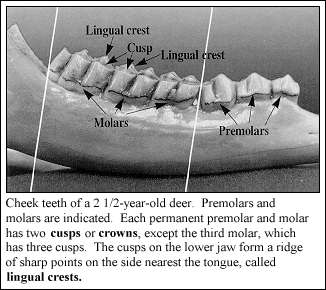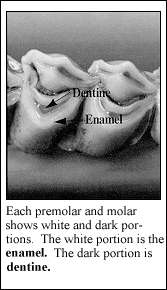How Old is My Deer?
Tooth Identification BasicsWhitetail and mule deer basically have two groups of teeth. The front teeth, or incisors, are used for collecting food. The back teeth or cheek teeth - molars and premolars - are used to chew and grind food. Between the incisors and molars is an open space along the jaw that has no teeth. (Note: In all photos, black line indicates the gum line.)
Front Teeth (Inisors):These are the front teeth on a deer jaw. When a deer is 5-6 months old, the central two incisors are replaced. The rest of the front teeth -lateral incisors and canine teeth - are replaced during the 10th and 11th month. Unlike horses, deer do not have upper incisors.
Cheek TeethPremolars: The first three teeth on each side of the jaw are called premolars. Deer grow two sets of premolars. The first set appear in fawns and last until the deer is about 1-1/2; years old, when permanent adult premolars push out the baby premolar teeth. An important characteristic of the first set of premolars is that the third premolar has three crowns or cusps. When the permanent teeth come, all premolars have just two cusps. Molars: The fourth, fifth, and sixth cheek teeth are the molars. Deer only grow one set of molars. Generally, six-month-old deer have only one molar when they enter the fall hunting season. Therefore, six-month-old deer usually have only four cheek teeth. By 1-1/2; years of age - the second fall - the second and third molar have erupted through the gum, though the last cusp of the third molar may still be below the gum line. All six molars and premolars are fully erupted by 2-1/2; years. The vast majority of deer in North Dakota are 2-1/2; years old or younger. To determine the age of animals in older age classes we need to look more closely at tooth wear.
|





